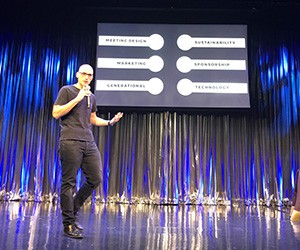The Smart Monday educational day at IMEX America kicked off at full stride on Monday, October 15, with Event Manager Blog Founder & Editor Julius Solaris revving up the crowd with an inspirational address that illustrated the powerful tool for change that meetings and events provide on a global scale.
“As meeting professionals, you have super powers to create change,” Solaris told the crowd during the keynote, part of the myriad educational opportunities available at Smart Monday, which is organized by MPI for the day before IMEX America really kicks into high gear with hosted-buyer appointments and a beehive of interaction on the exhibit floor. “It does not have to be a massive change—start small.”
Solaris utilized information he gleaned from researching some 350 events to gear up for the presentation and an accompanying “The Power of Events” whitepaper, available on his Event MB website.
[Meetings Today Podcast: Cutting-Edge Meetings Trends From Event Manager Blog's Julius Solaris]
The keynote was organized in six subcategories: meeting design, marketing, generationally, sustainability, sponsorship and technology.
“These are some events that set a legacy,” Solaris said of the 350 events he studied, adding that they all demonstrated lateral thinking, grit, risk taking and setting bold objectives. “How did they do it? It’s a journey that makes you feel good. It’s proof that events change lives.”
Meeting Design As a Tool for Connection
Tackling meeting design, Solaris singled out an event that addressed the massive 2011 earthquake in Christchurch, New Zealand, that killed 185 people and decimated the city’s downtown.
In 2012, meeting planner Jessica Halliday wanted to find a way to connect people with the city, so she chose an event in the earthquake “red zone,” where the most catastrophic damage occurred, using projection mapping technology to make the area an interactive art installation.
“The message is clear,” Solaris said. “Meeting design is about forcing a message.”
Marketing Your Event's Legacy
On the topic of marketing, Solaris said meeting and event organizers can use “legacy” to sell an event to potential attendees. Indeed, the theme of legacy was they key of the keynote, and also one of the overriding themes of the event, along with “experiential.”
Solaris used an example of a digital marketing event organizer from Brighton, England, who was promoting a conference on SEO. While the old school way of thinking was that social media and virtual meetings would “cannibalize” face-to-face attendance, it only took minutes for that tired concept to meet an undignified death once the conference social media attendance strategy was launched in the digital realm and select portions of the conference were offered for free online.
[Related Content: Social Media Seizes the Event Marketing Spotlight]
“There’s a big use of social media for events, and that’s to create ‘FOMO’—the fear of missing out,” Solaris said, adding that the event sold out in minutes after the announcement, with upwards of 4,000 people causing the event registration site to crash. “Social media increases the need to meet in person and it can scale events exponentially. People were afraid it would cannibalize their audience. This is how events are changing now.
"Engage with your community," he said. "It’s a year-long event.
Using Events to Shape a Generation
One of the most moving segments of the keynote was on the topic of “generationally,” using the former drug cartel city of Medellin, Colombia, which has a murder rate of approximately 6,000 people per year in the early 1990s, as an example.
In this case, the Colombian government thought up an “Incubator” event that featured art installations such as graffiti tours and performances in one of the South American city’s most notorious neighborhoods, La Comuna 13. The neighborhood is now one of the top tourism destinations in Medellin.
“This is how events change an entire generation,” Solaris said. “This is how they erase stigma.”
Solaris also used the example of an event that was intended to lesson the stigma of Alzheimer’s disease, with the fete having a party atmosphere and waggishly named "Alzheimer’s Fest."
The Expectations of Sustainability
The subject of event and meeting facility sustainability is a topic that started out hot a decade or so ago and has since ingrained itself in both the facility and meetings industry.
“It’s about making an impact without making an impact,” he slyly noted.
Solaris pointed to Cisco’s GSX event in Las Vegas, in which the tech giant approached MGM Resorts International about its priority of greatly reducing food waste.
MGM took the ball and ran with it, and the result was twofold: 715 pounds of food was donated to local food charities in the first year alone, and MGM rolled out the option for the many other events it hosted.
“Partnerships are key to delivering impact on the environment,” Solaris said, using Copenhagen’s Bella Center Copenhagen, and its use of dedicated wind turbines to provide power, and living food walls at Montreal’s Palais des Congres as other standout examples.
Sponsorships That Benefit the 'Greater Good'
Another heartwarming international events example came from Recife, Brazil.
Everyone knows that Brazilians are particularly obsessed with soccer, but the country has faced a challenge in organ donorship. To remedy this, Recife’s soccer team, Recife FC, launched a series of videos and other promotional events, using its fanatical fans as the stars, to promote organ donation.
The videos show fans in their home environments, but also used the team’s stadium and games as a platform to show banners promoting organ donation, for example.
[2018 Meetings Trendsetters: 20 Industry Agents of Change]
The team created an organ donation card just for fans that was available via its Facebook page and app. More than 50,000 cards and counting were issued, and organ donation increased 54 percent in one year.
“That’s the power of events,” Solaris stressed. “Sponsors want more than just logos and banners. Include ‘greater good’ opportunities such as silent auctions, fundraisers and donations. Think about change.”
Use Technology As a Connector
Finally, the somewhat vexing topic of technology took its turn to be addressed.
“It’s one of the most neglected parts of events,” Solaris said, and then added, sarcastically, “Technology and virtual reality is going to take face-to-face meetings away. How do we involve those that can’t make it? How do you dare not come to my event? Why do you disrespect me?”
Solaris used a BlizzCon eSports event at the recently expanded Anaheim Convention Center as an example.
“They created a powerful online attendee experience, and issued some free virtual tickets—they used technology,” he said, and then added another heartwarming example of Hyundai Motor Company used the most-watched event in the world, the Super Bowl, to immerse deployed soldiers in a 360-degree video environment where they could “watch” the game with their beamed-in families all around them.
“Technology is the best tool events have to connect those who can’t make it,” Solaris summed up.
Plan a Meeting, Change the World
Trotting out and joking about the commonly used graphic that shows coordinating events to be one of the top five stressful jobs, after enlisted military personnel, firefighter, airline pilot and police officer, Solaris left the audience with a final inspirational message.
“Even when you’re planning an event, you’re changing lives,” he said. “Your job is changing. My message to you is to go on and change the world.”
[Before You Go: How IMEX America's Smart Monday Is Advancing Meetings Education]







